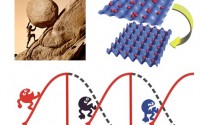Fifty Years Of Lasers: Cold and trapped – using lasers to approach absolute zero
- Date
- 21 Feb 2012
- Start time
- 7:30 PM
- Venue
- Tempest Anderson Hall
- Speaker
- Dr Andy Pratt

Fifty Years of Lasers: Cold and trapped – using lasers to approach absolute zero
Dr Andy Pratt, Department of Physics, University of York
Lecture 2 in a series of 3 celebrating the 50th anniversary of the LASER
Our everyday experience tells us that if light shines on an object, then that object will heat up, as happens when the Suns rays warm our skin. However lasers, the most powerful sources of light, can actually be used to cool atoms down to within a millionth of a degree of the lowest temperature that is theoretically possible, known as absolute zero (-273.15° Celsius or zero Kelvin). Over five decades, ever more sophisticated techniques, with exotic names such as Sisyphus cooling and optical molasses, have been developed that allow colder and colder temperatures to be reached. Such low temperatures are necessary to make improved measurements of the most fundamental properties of nature and for applications such as metrology and the atomic clocks used in global positioning systems (e.g. GPS). Exciting new technologies are also being explored such as quantum computers and lasers actually made of atoms instead of light. This talk will introduce the concept of laser cooling, the schemes used to achieve colder and colder temperatures, and how this field benefits our everyday lives.
The featured image shows an image of Sisyphus, a mythological king forever destined to roll a massive boulder to the top of a hill, only for it to continually roll back down again. Lasers can be used to create analogous hills which allows atoms to be trapped and then cooled to ultralow temperatures.
Report
by Carole Smith
The point at which molecular motion disappears (-273.15C, or 0 Kelvin), was determined to be absolute zero by Lord Kelvin in 1848. Since then a temperature of 100 picokelvins, less than a billionth of a Kelvin, has been achieved using lasers. Methods include Optical molasses or Doppler cooling: atoms are trapped and cooled in intersecting lasers; Sisyphus cooling: atoms move through a standing wave created by two laser beams, lose kinetic energy and achieve even lower temperatures; Evaporative cooling traps atoms at a controlled energy level, from which higher-energy atoms escape and drive down the temperature of the remaining atoms; and lastly Bose-Einstein condensation, in which atoms moving to lowest energy levels begin to act as one and share a quantum state.
Applications for this technology include atomic clocks, which use atoms cooled to absolute zero; GPS, which developed from the accuracy of atomic clocks; and atom lasers, which require the coherent state produced from Bose-Einstein condensate. The elusive quantum computer is also in sight. It aims to use single cooled atoms trapped in an optical lattice, representing individual binary digits, controlled by laser.
Video
Lasers – Approaching absolute zero from Yorkshire Philosophical Society on Vimeo.
Links
The link mentioned towards the end of the lecture is for www.learner.org.
Go to http://www.learner.org/courses/physics/index.html and follow links or search for “laser cooling”.
Further details about research at the Department of Physics in the University of York can be found at:
http://www.york.ac.uk/physics/